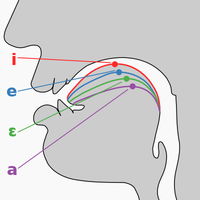How to Speak French - The Ultimate Guide to French Pronunciation

French is is often thought of as the language of love and romance. I don't know if that is true, but one may say that the beauty of the French language comes from the diversity of its vowels, the right balance between vowels and consonants, and the monotony of its rhythm.
While this beauty may delight your ears, it also means complexity. French pronunciation has a lot of complex structures and irregularities. This guide will help you understand these nuanced structures, so you're better equipped to face the adversities of learning how to speak French.

What This Guide Is About
Above all, this is a reference guide on French pronunciation. You will, most likely, not learn everything there is to learn in one shot. So feel free to bookmark this article and come back whenever you need it.
I will cover the multiple levels of pronunciations - namely segments (consonants and vowels), words and sentences.
This guide provides valuable content for learners on every level. Whether you are a beginner, intermediate or advanced, there is always something to learn.
Some parts of this article go more into greater detail than you may currently need. Feel free to skip an sections if you feel like this might be too advanced for you. Beginners need only the basics. Learn the foundations and circle back when you are ready. If you are an advanced learner, brush up on your basics and get ready to dive deeper.
What This Guide Is Not About
Again, this guide is not a one-shot read.
If you're a coffee person, you may think of this guide as a nice shot of espresso. If you're a tea person, enjoy this article like a cup of tea! Namely - slowly, or you might be burned out.
One important thing: do not get caught up in details. During my short life on this earth, I've had the opportunity to learn French, English, Turkish, German, Italian and Spanish (by order of mastery). One thing I've learned is not to fall into the trap of paralysis by analysis.
There are two extremes: people dedicating their lives to the intricacies of grammar without ever speaking and... the exact opposite.
This is NOT a grammar guide, but the same holds true for pronunciation. Both are sets of rules. Be aware of them, but do not learn them by heart (unless you have to). Let the exposure to the language be your teacher. Internalize the rules over time.
Alphabet: Sounds of the French Alphabet

French and English have the exact same alphabet, namely 26 letters of which six orthographic vowels and 20 orthographic consonants (meaning that these letters each refer to a sound).
French orthography is not easy. As you probably already know, French has a specific set of rules one has follow in order to read it. While Spanish is pretty straightforward, you'll see that we French like to make things "a tiny bit more complex".
There are more consonants and vowels than the individual letters of the alphabet. Here come the letter combinations that will produce extra sounds... or sometimes the same ones, but in a fancier way.
Without further ado, here is the French alphabet.
a, b, c, d, e, f, g, h, i, j, k, l, m, n, o, p, q, r, s, t, u, v, w, x, y, z
I recommend you listen to the pronunciation of the whole alphabet here.
Note: Contrary to what you might think “é”, “è” or even “ç” are not different letters. We will later see that they appear in specific contexts.
How to Pronounce Vowels
Although Spanish and French both come from Latin, history has made them quite distinct. As I mentioned above, one of these distinctions is the use of letters. In Spanish, it is safe to say that one letter corresponds to a single sound. Forget that for French! Different combinations of letters result in different sounds.
It might sound scary at the beginning, but it’s really not. English is similar in many cases. Actually, it’s even worse in English; in English, the same letter combinations might produce different sounds. Classic example: through vs. though.
Now there are exceptions in French as well and sometimes the same letter combinations are pronounced differently (examen, entrée). However, these exceptions are less frequent.

What Is a Vowel?
I was trained as a linguist. I like the nerdy aspect of languages. However, I will try to provide only information that is useful to you.
If I were to ask you the definition of a vowel, what you do you say? Pretty tricky, right?
A vowel is a sound of language made with the free flowing of air through the mouth. That means you do not block the air in your mouth when pronouncing a vowel. For the sake of this guide, let's say there are two main organs involved in the making of a vowel: the tongue and the lips.
Take a look at the following picture:

You can see from the picture that three factors influence the sound of a vowel:
- Height (how high your tongue is)
- Backness (how far back your tongue is)
- Roundedness (of the lips)
How is this useful? You obviously don't need to learn this stuff by heart. However, you can use this knowledge and apply it to what you already know. This way, in order to make new sounds, you can use the sounds you're already familiar with and from there adjust the position of your tongue to pronounce them like a native!
Note: In this article, you won't encounter any atrocities such as “here’s the sound “i” like in “tree””. It’s just not accurate. Every language has different sounds, some of which cannot be “transferred” from one to another. Instead, I will refer to links to this website for each sound so you can hear it.
Individual letters
In French, the single letters "a, e, i, o, u" all refer to a single respective sound. However, these sounds are all different from the English ones.
Note: "y" is considered a vowel. It is true to the extent that it is sometimes pronounced as "i" (the French version). In other cases, it as the same function as in English.
"a" as in “oh la la!”
papa (dad), patte (animal’s leg), bas (low)
Example #1:
"Je m’appelle Jack" (My name is Jack)
Example #1:
"Quel âge as-tu" (How old are you?)
The French "a" sound is the same as the one in Spanish.
The English “a” (as in "cat") is made with the tongue pulled forward. It is almost the same sound in French, except the tongue is placed a bit lower.
Exceptions: In certain cases, you can find the “a” sound in different forms.
là, femme, violemment
Nothing to worry about though. These cases are rare and very predictable. “Là” and “femme” you can learn by heart. In other cases, “e” + “mment” will result in a “a” sound.
The “e” sound
Why is there no example up front? Because this one is tricky and the letter "e" actually refers to (at least) two different sounds.
The closed "e"
There is (at least) two kinds of "e". The first is called the closed "e", with an "accent aigu" (acute accent).
It is pronounced the Spanish way in words like these:
béton, piéton, héros
Example #1:
Example #2:
"Je suis infirmier" (I am a nurse)
The reason this sounds has an acute accent on it is to indicate that it is pronounced with the mouth slightly closed.
The open "e"
The second one is the open “e”, with an "accent grave" (grave accent) because it is pronounce with the mouth open.
père, frère
This sound will also occur before two double consonants. As we see in these examples:
Example #1:
"Comment t'appelles-tu?" (What is your name?)
Example #2:
"Le sport m'intéresse" (I'm interested in sports)
“e” + “ll” will result in the “accent grave”/closed type of “e”.
The circomflex "ê" is also a closed "e".
tête, fête, bête
Everywhere else: When not specified, the “e” sound will be open, such as in:
nerf, cerf, serf
The Silent "e"
Remember these previous examples?
tête, fête, bête, père, frère
The "e" in final position is never pronounced. Unless you either are reading poetry or want to have a southern French accent.
Rather, the final "e" in French is here to indicate that you must pronounce the preceding consonant. In other words, if we take the imaginary word "têt" (from real word "tête"), the final consonant would be silent.
“i” as in “chic”
dix, lit, île
Example #1:
"Je suis infirmier/infirmière" (I am a nurse)
Example #2:
"Je suis très riche" (I am very rich)
This is an easy one. In French the “i” sound is always pronounced as in “chic” or “petite”.
There is one caveat however. As we saw earlier, vowels are always short in French. As a result there is no distinction between examples like “(to) live” and “leave”. This is why French people have a hard time differentiating “beach” and... well the other word.
So in order to pronounce the “i” sound, you will do a shorter version of the English “ee” sound.
Note: In the previous example, you might have noticed the “î” with a circomflex. This hides a lost “s” that is not pronounced anymore (example in English: island). This does not change the pronunciation.
Exceptions: You will encounter the following cases:
style, y
These are just regular “i” sounds.
The "o" sound
This one is less easy. There are two kinds of “o” sounds, just like “e”. There is a open and a closed one. This time, however, there is no accent to tell the difference. But hold on, it’s not as difficult as it sounds!
The closed "o"
First, we have the closed “o”.
Ado, chrono, opéra
Example #1:
"Quelle est ta couleur favorite ?" (What is your favorite color?)
Example #2:
"Je viens de Los Angeles" (I'm from Los Angeles)
Why do these words not look French at all? You won’t find many short words in French featuring "o" letters. Why? I don’t know, we like to complicate things. You will see in a further section that “o” can also appear as “au” and “eau”. These patterns actually appear more often.
The closed “o” will appear at the end of a syllable (if there is no pronounced consonant).
Note: This sound is not made the British or American way. This is a single sound. Your lips do NOT move!
The open "o"
Secondly, we have the open “o”, as in these examples:
Example #1:
"Il fait beau dehors..."(the weather is good outside)
Example #2:
"Où est ton ordinateur portable"(Where is your laptop?)
The open "o" appears in specific contexts, such as:
Case #1: "o" is followed by a final consonant (other than “s”) as in:
frotte (rub), sotte (stupid-FEM), glotte (glottis)
Note: the "tt" counts phonetically as one consonant.
Case #2: "o" is followed by two consonants (other than two “s”'s) as in:
porte, ordinateur, portable
Note: This sound will not be represented by letter combinations such as “au” and “eau”.
“u” as in “déjà vu”
This one is really tricky for English speakers. This is not the regular “u” sound you can find in every language. Again, we like to complicate things.
déjà vu, flûte (flute), zut (oops)
Example #1:
"Comment t'appelles-tu?" (What is your name?)
Example #2:
"Es-tu célibataire?" (Are you single?)
The trick is to pronounce an English “u” and then bring your tongue forward. You’ll get it with practice!
Exceptions are very rare. Examples are:
eu, aigüe
The former is very common so you’ll remember easily. The second one is too specific (and not that common) for me to explain it here.
Letter combinations

French has 14 vowels. That is more vowels than most languages have. Spanish for example has only 5. You can see that it is a huge number.
There are only six vowels in the alphabet. To solve this problem, French had to combine letters with each other. And now, you have to learn these combinations!
“ou” as in “en route”
You thought we didn’t have a proper “u”? We do!
route, goût (taste), nous (we)
Example:
"Ma couleur favorite est le rouge." (My favorite color is red.)
Again, there is no long vowel in French. So the thing is to (again) make a long “u” English sound as in “route” but to keep it short.
There are very few exceptions in which "u" is actually pronounced "ou". But these words have foreign origins.
“eu” as in “queue”
As you can see, we do not pronounce this sound as in “cue”. More examples:
queue (tail), feu (fire), feutre (felt pen)
Example:
"Non elle est bleue" (No, it is blue)
We could say this is a closed “eu”. The rule is that it always appears in a open vowel (with no subsequent consonant) in a word.
“eu” as in “chef d’oeuvre”
Another one? Yep.
oeuvre, beurre, soeur
Example:
"Je suis professeur" (I am a teacher)
As you see, this “eu” can appear as both “eu” and “oeu”. It always appears in a closed syllable (with at least one consonant at the end).
“au” and “eau”
I mentioned these two sounds earlier. This is also a form of the “o” sound. Oddly enough they are also words in and of themselves.
au (to the), eau (water), auto (automobile), bâteau (boat)
Example:
"Il fait beau aujourd'hui" (The weather is nice today)
The Nasal Sounds
French is probably known for this. While most languages of the world feature sounds from the oral cavity exclusively, French uses the nasal cavity as well.

English actually does too, but only with consonants. How do you sound when you have a cold? Your “n”’s become “d”’s and your “m”’s become “b”’s. That’s because the “n”/"m" sounds are made with air coming out of the nasal cavity.
The same thing happens with vowels. We French people like to talk with our noses. We make those vowels by pronouncing them from the nose. Nasal vowels are tricky at the beginning, but you’ll get use to it with practice.
“an” as in “restaurant”
You can listen to it here.
restaurant, banc (bench), flanc (kind of pie)
Example #1:
"J'ai trente ans" (I'm thirty years old)
Try pronouncing the “an” from the English “restaurant”. Then get rid of the “n”.
This sound is also realized as “en”:
cent (hundred), lent (slow), enfant (child)
Example #2:
"Elle habite au centre ville" (She lives downtown)
It will usually be realized as “am” or “em” with a subsequent “p” or “b”:
ampoule (light bulb), empathie (empathy), ambiance (vibe)
Most of these words are transparent though and shouldn’t cause too much difficulty.
"in" as in "Hein??"
French people will say "hein?" whenever they don't understand what you say. This sound can have many forms, namely:
“in”, “im”, “ein”, “ain”, “en”
I admit, this one is really tricky. You have to learn them by heart. Notice that “en” can also be realized as in “in” (examen).
fin, impossible, plein, pain, examen
Example #1:
"Es-tu ingénieur ?" (Are you an engineer?)
Example #2:
"Es-tu Américain ?" (Are you an American?)
Oddly enough, you can pronounce it when you exaggerate the pronunciation of “can’t” or “and”. Then only pronounce the vowel. Then slightly lower your palate.
“on” as in “garçon”
You can make this sound by first making a French “o” (remember, don’t move the lips) then by making the air flow from your nose.
garçon, chignon, champignon (mushroom)
Example:
"Où est ton ami ?" (Where is your friend?)
For a start, the American “don’t” is close enough.
Semi-Consonants: Between Vowels and Consonants
You haven’t got enough? There are also sounds which are technically between vowels and consonants. Nothing too alarming though, you also have them in English, namely “w” and “y”.
I will not cover “y” or “i” as in “Pierre” because every English speaker already knows how to do it.
“ou” as in “oui”
oui, Louis, fouet (whip)
This is just a “w” sound. When you find “ou” in front of another vowel, the “ou” sound will become a “w”. Pretty simple.
“ui” as in "huit"
Huit (eight), nuit (night), puits (well)
Another tricky one. The thing is to first make a “u” sound (not the English “u”, look up if you’ve already forgotten). Then do a “w” sound but keeping the tongue forward. You'll get it right with a bit of training!
How to Pronounce Consonants
There are two challenges regarding consonants for English speakers: the French "r" and silent consonants. The rest is pretty much the same as in English. However, I will cover most of what works similarly in English and also the peculiarities of French consonants.
Before getting started
Before we start, I would like to clarify two things that will make everything else easier.
-
Unlike in Italian, double consonants such as "tt", "ss", etc. are always pronounced as single consonants. There is no emphasis.
-
In English, consonants like “p”, “t” and “k” are sometimes aspirated. We do NOT do that in French. That’s one of the reasons French people typically say “appy” instead of “happy”.
Let's start with the easy stuff.
Individual letters
I have good news before we start. The following consonants are identical in both English and French. Therefore, there is no need to cover them.
b, d, f, m, n, v, w, x, y, z
For other consonants, you will see that they can be pronounced differently in different contexts. Moving on to the hard stuff.
“c” as in “café” or “cinéma”
“c” will be realized as a “k” in front of:
a, o, u, ou, an, on
and as a “s” in front of:
e, i, in, en
For concrete applications:
café, camping, cinéma, cent
Example #1 ("c" as in "café")
"Lulu préfère le thé au café" (Lulu prefers tea over coffee)
Example #1 ("c" as in "cinéma")
"Nous allons au cinéma" (We're going to the movies)
Did you know? If you really want to get geeky on this, there is a reason why there is a shift of consonant with different vowels. See, the "s" sound is made with the tongue on the front of your palate. The "k" sound is made with the tongue on the back of the palate. What's do "a, o, u" and "e, i" have in common? The former are made from the back while the latter is made from the front of the mouth. To make it easy on your tongue, our brains figured out a way to make the process easier. But we kept the same letter!
The "ç" (c cédille)
Take these words:
garçon, glaçon, ça
The "c" sound is pronounced here as "s". What did we say about "c" followed by "a", "o", etc? That's why there is a cedilla on the "c", to turn it into a "s" sound.
Example
In the old days, we used to say "garce" for girl and we still say "garçon" for boy (not for waiter). You can clearly see that the root of the word is "garc", so there is no reason to write it with an "s". That's where the "ç" comes from.
“g” as in “garçon” or “girafe”
Same rule applies here: “g” in front of “a”, “o”, “u”, “ou”, “on”, “an”;
and as a “j” in front of “e”, “i”, “en” and “in”.
garçon, gourmet, giraffe, géant
Example #1:
"Elle regarde la télévision" (She's watching TV)
Note: g + u will always result in “g” as in:
gui, guet, guillotine
Example #2:
"Je suis allergique" (I'm allergic)
“h” as in ... nothing
I was tempted to write “h” as in “appy”. Simply put: we do not pronounce the letter h. Ever.
Hâche, hachis parmentier, haute couture
“j” as in “joie de vivre”
In English, “j” is pronounced with a “d” sound. Not in French. Only the last part is kept.
Je, joie, joli
See section on “g” to see when “g” is pronounced “j”.
"q" as in "bouquet"
Orthographically, the letter "q" is used exactly the same as in English. It is almost always found with a subsequent "u" as in:
bouquet, quête (quest), roquette (rocket)
In English, it is often pronounced "kw". It is simply pronounced "k" in French.
Two exceptions, but same sound:
Qatar, coq (cock)
The notoRRRious "r"
This is hands down the most difficult sound you will encounter in French. If you're familiar with (Standard) German, you already know how it sounds.
If you're an experienced gargler, you'll know that there is something hanging at the back of your mouth. This is called the uvula.
What makes this strange "r" sound is the vibration of the uvula against the roof of your mouth. Hence this special sound you make when you gargle.
The key is to train yourself to make this sound by exaggerating it. Do the gargle sound and then slowly apply to a more light "r".
"s" as in "misérable"
You probably already know how to make a "s" sound. I will only cover the exception to the rule.
laser, phrase, misérable
Example:
"Je n'écoute pas de musique" (I don't listen to music)
This is simple: "s" will be pronounced "z" between
two vowels.
Note: On the other hand, the "s" will be doubled (as in "ss") when pronounced as a real "s" sound.
Letter combinations
Again, French has slightly more consonant sounds than it has letters. This means you have to learn some more letter combinations. No worries though, only two of them are relevant.
"ch" as in "champagne"
The "ch" sound is equivalent to the "sh" sound in English. In French, there is no "t" sound in "ch". That's why these words are pronounced with as "sh" sound in English, because they're French.
champagne, Chanel, chauffeur
"gn" as in "Cologne"
Notice the word "Cologne". In English, the final consonant is pronounced "n". In French, we pronounce it like this.
Cologne, montagne, agneau
It's pretty straightforward: it is a combination of "n" and "y", as in "canyon".

Common Mistakes With Consonants
French pronunciation is not easy. Unless you know the International Phonetic Alphabet, it can be tough to decipher the way it is written. To be honest, there are a couple of things I did not yet cover. Among these, there three main mistakes often made by English speakers.
Mistake #1: "p", "t", "k" sounds
What's the common thing between these three examples of English?
put, took, cut
I've said it before but I probably need to repeat it. I have no idea whether native English speakers are aware of this or not but here the "p", "t" and "k" sounds are aspirated, meaning that their is a slight "h" sound at the end. You'll have to train yourself not to do this when pronouncing (for example) these words:
poule, tour, cours
Special note: Coming back to the "t" sound in English, what do these three words have in common?
foot, put, cut
The final "t" is what we (linguists) call a glottal stop, meaning that it's not a "real" "t". You don't pronounce the "t" the same way in "put" and "took". Avoid that when speaking French! For us, a "t" is a "t" everywhere!
Mistake #2 : The Final "L"
Ever heard of the "Dark L"? In English, the "L" sound is pronounced differently at the beginning, in the middle and at the end of words.
In other words, the "L" in "leaf" will sound different as that of "feel".
In French, we pronounce every "L" as an "onset L" in English.
Chanel, belle, elle
Example:
Mistake #3: The Silent Letters "d", "p", "s", "t", "x"

Why do we often have silent "e"'s at the end of words in French? Partly because without them "d", "p", "s", "t" and "x" are silent.
grand (big), coup (strike), ras (close), pot (pot), faux (fake)
Notice what happens when you add an "e" these words.
grande (big-FEM), coupe (haircut), (il) rase ((he) shaves), pote (buddy), fausse (fake-FEM)
If you don't know the answer, in the first case the final consonant is mute, whereas it is pronounced in the second.
Example #1 : silent "d"
"Le grand ou le petit ?" (The big one or the small one?)
Example #2 : regular "d"
"...en grande forme" (...in great shape)
Now this is not a grammar guide, so you'll need to learn this by yourself. Just remember that these letters are silent at the end of words. One reason for this is because when you add a suffix to the word, the silent letter magically gets "activated", as in:
Paris (silent "s") + -ien -> Parisien ("s" as "z")
More on Silent Letters
You thought you were done with silent letters? There are so many exceptions. Unfortunately, there are so many exceptions that I won't be able to cover all of them in this article, especially because you kind of have to learn them by heart. Here is an exhaustive guide to silent letters.
How to Speak French on the Sentence Level
Wait, why jump straight from sounds to sentences? Didn't I forget the word level? Good question. The original Ultimate Guide to Spanish Pronunciation has a whole part on words, for one reason: stress. Word stress is not relevant in French. I will come back to this later. For now, let us define what stress is.
Stress Rules: What and How to Stress

What Is Stress in French?
Stress is not the experience of learning French... You probably already know what it is. In case you do not, stress is emphasis put on a certain syllable in word. What kind of emphasis? In French, several factors come into play in the realization of stress. You only need to know one: length. Stressed syllables are slightly longer. That's it.
Word vs. Phrasal Stress
So I said earlier that word stress in French wasn't really relevant. Let me explain. Take these individual words:
buvait (drank), café (coffee), beurre (butter)
The stress is always on the last syllable. Now take this sentence with the same words combined:
"Elle buvait du café au beurre" (She was drinking butter coffee)
The stress also falls on the last syllable. Indeed, stress is not assigned to individual words but at the end of phrases. Phrases can be single-word phrases, sentences or parts of sentences.
For simplicity, we will say that stress in French also falls on the last syllable of a sentence.
How does that sound? All syllables in a sentence are pronounced with the same length and intensity, except the last one, which is the stressed one. For you musicians out there, we may associate this with the staccato rhythm. In other words, we French (almost) talk like robots.
Intonation: How to Use the Right Tone

Unlike Chinese and other languages, French doesn't have tone on the word level. However, on the sentence level, it is crucial that you get the intonation right if you want to be understood. You might already have an intuition of how it works.
You're probably already familiar with the raising tone in questions and the falling tone in declarative sentences. True, this is similar in many languages. However, this guide will teach exactly how to do it so you don't have to rely on guesswork.
Note: Intonation will most often be on the stressed syllable, that is one the last one. However, we'll see that there can be multiple intonations in a single sentence.
Declarative Intonation
For starters, a declarative sentence is a sentence in which the speaker states a fact. There are two different intonation patterns according to the sentence itself.
Example #1: Short sentences
"Tu es très aimable" (You're very nice)
Notice how the intonation falls on the last syllable "mable", also the stressed syllable of the sentence. This is typical of declarative sentences.
Example #2: Long sentences
You may have noticed two different intonations here. You may also argue the presence of two stresses, as the sentence is split up by the conjunction "mais".
Another reason would just be the length of the sentence. Let's look at another example:
In order to make the sentence "more stable", French speakers will vary the intonation in a long sentence. The pattern is a raising tone followed by a final falling tone.
Interrogative Intonation
In French, there are several ways to ask a question. Each of these ways has different intonation patterns.
"WH" Questions
These are called "WH" questions because, of the "wh-words": "what, who, where, which, whose, etc". Here are the interrogative pronouns in French:
Pourquoi (what), qui (who), comment (how), quel (which), où (where), etc.
A raising intonation will be pronounced on the last syllable of the interrogative word, such as in this example:
Example:
"Comment t'appelles-tu ?" (What's your name?)
Yes/No Questions
Yes and No questions follow a different pattern.
As with declarative sentences, the tone falls on the last syllable. However, this time we're dealing with a falling tone (no pun intended).
Example:
"As-tu vu Ashley ?" (Have you seen Ashley?)
You're probably familiar with the "est-ce que" question form. The same pattern applies.
Example #2
"Est-ce que le train arrive ?" (Is the train coming?)
Exclamative and Imperative Intonation
Exclamative and imperative sentences work the same way when it comes to intonation. The common characteristic is a sharp falling tone.
Example #1:
"C'est délicieux!" (It's delicious)
As you can hear, the last syllable is suddenly falling at the end.
Example #2:
"Tu es plein d'énergie ce matin !"
(You are energetic this morning)
Longer sentence but same pattern. Now, we also get the same sharp falling tone with imperatives:
Example #3:
Note: You may have noticed differences in intonation in those recordings compared to what I said. The speaker will vary his intonation unconsciously according to the context and how he/she speaks. Please note that what I described is the common rule and the general tendency.
Liaisons or How to Connect Words in Sentences

So we learned about the strange spelling of French and namely that there were silent consonants at the end of words. In this section, we will see that this gets even more complex: there are some cases in which these consonants are pronounced. That's why we keep writing (some of them) in the first place.
This phenomenon is called "la liaison". There are two important cases: the one in which you must do it (mandatory liaison) and the one in which you cannot do it (forbidden liaison). Another case is optional liaison which I will briefly cover. It is not necessary to learn the latter. In fact, if you are a beginner, I advise you to skip this part (optional liaison) to avoid information overload.
So what is liaison? Let's take the plural suffix "s". This consonant followed by a vowel, as in the example below, will be pronounced.
Les amis
The determiner "les" will be pronounced as usual except for a "z" sound connecting the two words. In other words, liaison is just the "activation" of certain consonants before vowels. The purpose is to make it easier to pronounce.
The pronounced consonant will most often be "s", "n" or "t". Remember that the letter "s" turns into a "z" sound between two vowels. A liaison with "s" will then also result in a "z" sound.
Mandatory Liaison
The first kind of liaison is the mandatory one, meaning that you must absolutely pronounce it if you want to speak correctly.
Several cases imply the use of mandatory liaison. We will see that the part of speech (noun, verb, adverb, etc.), as well as other factors, determine its realization.
Case #1: Determiner + Noun
In French, determiners followed by a noun starting with a vowel will trigger liaison.
Examples of determiners: le/la (the), de/des (some), mon/ma (my), son/ses (his/her), aucun (none), mon (mine), etc.
Example #1:
Où vivent ses enfants ? (Where do his children live?)
Example #2:
Il est marié et porte toujours son alliance. (He's married and always wears his ring)
Case #2: Adjective + Phrase
In French, adjectives often come after the noun. However when they do come before the noun (starting with a vowel) liaison occur.
Example:
Lilly n'a pas de petit ami. (Lilly doesn't have a boyfriend)
Case #3: Pronoun + Verb
It doesn't matter if it's a subject or object, a pronoun will trigger liaison in front of the first vowel of a verb.
Example:
Nous allons au cinéma (We're going to the movies)
Case #4: Verb + Inverted Pronoun
Same thing here. In formal French, the subject pronoun is inverted in the context of a question.
Example:
Fait-il froid dans ta chambre ? (Is it cold in your room?)
Case #5: Preposition, Adverb or Conjunction
If you don't know what these are, I invite you to check out this blog post. These parts of speech also trigger liaison before a vowel.
Example #1:
Je travaille dans un hôpital. (I work in a hospital.)
Example #2:
Il est très amusant, mais non. (He's very funny, but no.)
Example #3:
C'est arrivé quand elle faisait de l'escalade. (It happened when she was rock climbing.)
Note: As a side note, please note that the verb "être" (to be) and all its inflections ("je suis", "il est", "ils étaient", "nous serions", etc.) also trigger liaison (final consonant of "être"). Although this is traditionally recognized as "mandatory liaison", I will argue that it is not any more. Many native speakers (myself included) omit this liaison.
Forbidden Liaison
This next part is dedicated to liaisons that must not occur. The following cases are really specific. I do not recommend that you learn them by heart. This will not help. I advise you to become aware of them and train yourself by practicing and getting feedback, as well as a lot of listening and exposure to spoken French. If that confuses you, don't worry. The last part of this article is dedicated to the practice of French.
Note: Since liaison is forbidden in this case, it will be indicated with a "/" sign in the following examples.
Case #1: Singular Noun + Following Word
Case #2: After the Verb
Case #3: After Inverted Pronoun
Tes enfants sont-ils / à la maison ? (Are your children at home?).
Case #4: Nominal Phrase
Example #1: Noun + Adjective
C'est un enfant / intelligent (S/he is a smart child).
Example #2: Nominal Phrase + Verb
Les olympiens / ont concouru pour la médaille d'or.
(The Olympians competed for the gold medal.)
Case #5: After "Et"
Il est malade et / au lit. (He's sick and in bed.)
Case #6: Before Aspired "H"
In French, some words beginning with "h" allow for liaison and some don't. The latter case is the "aspirated h" (it doesn't mean it is pronounced). Here's an exhaustive list of words beginning with an aspirated h.
Example:
Case #7: After Interrogative Adverbs
Interrogative adverbs, namely "quand" (when) and "comment" (how) do not allow for liaison.
Example:
Elle est parfois en retard, mais pas / habituellement.
(Sometimes she's late, but not usually.)
While writing the article, I came up with an exception to the rule.
Comment allez vous?
For a reason I cannot explain, the "t" is actually pronounced in this example. This is part of fixed expressions in which liaison occur.
Here's more about mandatory/forbidden liaison and fixed expressions (in French).
Optional Liaison
There is another case in which liaison is optional. Again, if you are a beginner, this part of the article has no use for you. I'm sure you have more important stuff to learn. If you're not a beginner or you're just curious, then you can bear with me for this next part.
Optional liaison is used in formal contexts, namely when reading out loud or with people wanting to show off. It has a more classy sound to it. It occurs in two main cases.
Case #1: Plural Noun + Adjective
This is pretty straightforward. The plural "s" is "elligible" for liaison in the context of a plural noun followed by an adjective.
Example:
Y a-t-il des magasins ouverts aujourd'hui ?
(Are any stores open today?)
Case #2: After Specific Verbs
The following verbs
être (to be), aller (to go), avoir (to have), devoir (must), falloir
(must), pouvoir (can), vouloir (to want)
followed by any word can, if the speaker feels like it, result in liaison.
Example #1:
Ses enfants sont à l'école. (Her kids are at school.)
Example #2:
Note: The second liaison is not pronounced in the audio, although it could be.
Example #3:
Que veulent-ils pour le brunch ? (What do they want for brunch?)
Note: In the latter case, you may have noticed the presence of a hyphen in "sont-ils" and "veulent-ils". These hyphens only appear with pronouns in the context of a question. That's why "a" (avoir, have) + "il"/"elle" (he/she) result in "a-t-il", "a-t-elle". There was no "t" in the first, it was added for convenience.

How to Practice Your French in Conversation
Learning all of this won't help you unless you apply it. That is the difference between head knowledge and implicit knowledge. In the former case, you can write entire books on a subject without actually "talking the talk". In the latter case, your knowledge has become instinctual - as that of a native speaker.
Good practice aims toward the latter direction. Again, the aim of this guide is not to make you learn for a test but to show you how the system works. That way, you can notice particular phenomena and reproduce them after exposure to the language.
But how do you actually practice your French? There are several ways to go about it. The most natural is conversation.
The "How-To": Tangible Advice to Up Your French Game
If you're reading this article, you're probably learning French. If you're learning French, you're probably doing so because you want to engage in conversations.
Whether mastering conversation in French is your goal or not, here's the good news: conversation is an opportunity to practice your skills.
That means you can use conversations to practice anything in this article. Remember though: don't get caught up in details and focus on conveying meaning. I'll cover more on that below.
For now, here's some practical advice you can apply to practice your French.
Method #1: Get a Real Partner
The most natural, down-to-earth way to practice any language is to engage in authentic interactions with real human beings.
There's no secret to this: the sharper your social skills, the easier it will be for you to find someone to practice with. Here's my tips to find language partners.
-
Go out. If you live in a city, there are probably tons of events related to language/cultural exchange. When I lived in Frankfurt, Germany, there were weekly events where people could practice their German. You can find friends easily there.
-
The Internet. If you're reading this article, you probably know what I'm talking about. Ever heard of tandems? These are language exchanges where people meet somewhere in public to chat casually. You can find tandems on Facebook groups, on the Meetup app and through many other media.
-
Be Adventurous. Many of us, I included, won't follow this advice but that may inspire some people. Laoshu, a polyglot broadcasting himself on YouTube, made tons of videos of him chatting up people in malls in various languages. Here's an example. It takes a bit of courage but the reward is huge.
Method #2: Get an Online Partner
If for some reason you cannot find or do not have the time to engage face to face with a native French speaker, there is always a convenient way: the Internet.
While this is no substitute for authentic live interactions, I actually advocate both ways. Let's face it - we're all busy in the modern world and only relying on actual meetups and tandem wouldn't be productive. The advantage of online chatting or calls is that it is accessible whenever you want.
There are several ways to go at it. The easiest one is chatting. I find Hellotalk to be the most convenient app. You chose your native language and the language you want to learn and you're ready to go. Online chatting allows you to pause and think of what you have to say and how you're going to say it - without the pressure of a live interaction. This is especially good for beginners trying to ground themselves in the language.
The next level is live calls, whether it be on Skype or any platforms (Hellotalk for example). This approach is more stressful but it is a good exercise to get you ready for real life interactions. The secret is to keep going. Don't just do it once and quit because it's hard. The more you'll do it, the easier it'll become.
Method #3: Get an Online Tutor
A tutor is not a language partner. The latter is more like a friend. The role of a tutor is to guide you from A to B. In other words, a good tutor corrects your mistake and give you practical tips to improve your grammar and presentations.
You usually have to pay them. But a language partner won't bother as much with feedback because they have no interest to do so. Plus, partners are here to interact, not to give you lessons. The go-to website for language tutoring is iTalki.
One caveat: the polyglot Steve Kaufmann (16+ languages) warns against overly critical tutors. A tutor who corrects you too much does not leave you enough room for expression. It impedes on your self-esteem and make you question your language skills. That's why Steve recommends that you take feedback after the sessions. In other words, tell your tutor to take notes and send them to you later. This will most likely enhance your experience.
Mastering the Art of Language Exchange
Language exchange is not easy. On the one hand it is cooperation in its very nature, as two people exchange knowledge about their languages. On the other hand, it is also competition. Indeed, both parties are in because they want an opportunity to practice. In the best case scenario, a compromise is found and both languages are practiced equally. However, in my experience, often times one person has it easier than the other and has it their way while the other silently swallows their resentment.
What I've just described is just one aspect of language exchange which has to do with social dynamics. There are many other components. In this last part of the article, I will suggest three practical tips that will help you get the most out of language exchange.
Tip #1: Embrace Your Fears
You've probably heard that the number one fear we have is the fear of public speaking. We're all scared to be embarrassed. When it comes to language learning and practicing your pronunciation (or anything, really) fear is a real obstacle.
Fear will make you judge yourself and analyze every word you utter. If you're practicing French, you'll probably get stuck choosing the right word, deciding whether a noun is masculine or feminine, etc.
My advice is to accept the fact that you're learning. Whatever your level is, acknowledge it. Once you accept it, you shift your mindset. All of sudden, you don't seek perfection but progression. You're striving instead of coping.
The first foreign language my girlfriend even learned was German. She visited Germany several times but hadn't had the opportunity to practice for years. She came to visit when I was an Erasmus student in Frankfurt. At the train station, she was excited to finally practice her German. She was so slow to speak that I actually felt embarrassed for the employee and for the people waiting behind us. That's when I realized that she had no fear. She didn't care what other people thought of her German skills. My German was better than hers but I was less comfortable practicing it. In retrospect, I think I would have learned much faster had I not been that fearful. Don't be too attached to the outcome.
Tip #2: Give Before Your Receive
I can really get emotional on this. I mentioned Hellotalk in the previous section. To be honest, most people on there are annoying. The one reason for this is their "taker" mentality. I often get messages like "I'm learning French, please help me!!!". This kind of people only care about themselves. They'll tell you everything about why they absolutely need to learn French without ever asking you if you even speak their language.
Hence the tip "give before you receive". I believe that if everyone did that, everyone would benefit more. Offer your help before you ask for some.
I'm not perfect, I've been guilty of that too. I once did two tandems with German speakers during the same week. They never called me back after that. I think the reason is that I only spoke German without actually offering my help in either English or French. I made it all about me.
You might think it has nothing to do with practicing your French pronunciation. Trust me, it does. I believe that if you help them first, people will reciprocate and actually help you back. Discard those who don't.
Tip #3: Learn From Feedback
I've mentioned the difference between language tutors and language partners. The former providing feedback and the latter "just being your friend". This is not entirely right. You may also rely on partners to ask for advice. I've talked about how constant live feedback (a.k.a corrections) were lethal to the conversation. It is true that when talking, no one likes to be corrected. Sometimes people get silently offended and they don't feel safe to talk any more.
I've found that the most important mistakes were not those you make on the spot but those you make over and over again. That way, when you ask your partner about your mistakes after the conversation, they will usually remember those you constantly make. Those are the ones you need to fix first any way! At the end, everybody wins.
In summary, language exchanges are opportunities to practice what you know but also to update what you know. They are great opportunities to learn but many people get caught up in the conversation without actually learning anything (I know, I've been there!). Don't fall into that trap! When the interaction is over why not take notes of what you've learned?

Recap
This guide provided you with a step-by-step explanation of French pronunciation. The different units of speech, namely sounds, words and sentences were reviewed.
I recommend that you practice these units either one at a time or in an integrative way. Do not make the mistake of neglecting intonation, especially at the sentence level. This, more than knowing how to pronounce individual words, will make the difference between a somewhat good accent and a excellent one.
Lather, rinse and repeat. Take what you've learned and apply it in social environments. The secret to good pronunciation is not to know the rules by heart but making your knowledge second nature.
